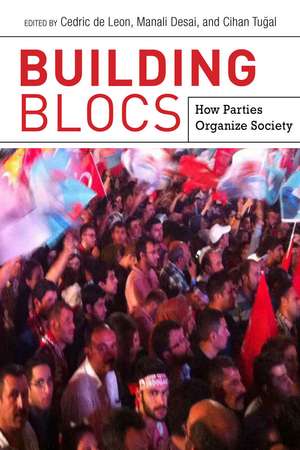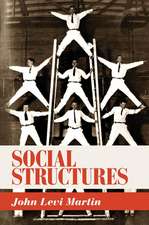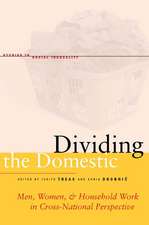Building Blocs: How Parties Organize Society
Editat de Cedric de Leon, Manali Desai, Cihan Tugalen Limba Engleză Paperback – 26 mai 2015
This politicization of divisions, or "political articulation," is neither the product of a single charismatic leader nor the machinations of state power, but is instead a constant call and response between parties and would-be constituents. When articulation becomes inconsistent, as it has in Indonesia, partisan calls grow faint and the resulting vacuum creates the possibility for other forms of political expression. However, when political parties exercise their power of interpellation efficiently, they are able to silence certain interests such as those of secular constituents in Turkey. Building Blocs exposes political parties as the most influential agencies that structure social cleavages and invites further critical investigation of the related consequences.
| Toate formatele și edițiile | Preț | Express |
|---|---|---|
| Paperback (1) | 210.70 lei 6-8 săpt. | |
| Stanford University Press – 26 mai 2015 | 210.70 lei 6-8 săpt. | |
| Hardback (1) | 644.44 lei 6-8 săpt. | |
| Stanford University Press – 26 mai 2015 | 644.44 lei 6-8 săpt. |
Preț: 210.70 lei
Nou
40.34€ • 41.51$ • 34.00£
Carte tipărită la comandă
Livrare economică 01-15 martie
Specificații
ISBN-10: 0804794928
Pagini: 256
Dimensiuni: 152 x 229 x 20 mm
Greutate: 0.34 kg
Editura: Stanford University Press
Colecția Stanford University Press
Recenzii
Notă biografică
Cuprins
This chapter outlines the theory of political articulation upon which it builds a new theory of parties. It begins by providing a systematic review of the existing literature on parties and social movements, arguing that existing theoretical frameworks do not sufficiently account for the process of creating both social change and social order. It argues that attention to political articulation is crucial in providing such an account. Building on the work of several theorists, including Gramsci, Laclau, and Althusser, the chapter discusses how parties draw together different constituencies and create common ground, while at the same time constructing boundaries of 'us' vs 'them'. This fundamentally political process is central to the formation of the major cleavages in society, while the integration process is fundamental to social order. The chapter outlines the means of articulation employed by different parties, and outlines the reasons why some parties are more successful than others.
The scholarly debate on the origins of working class formation correspond to what Pierre Bourdieu (1989) once called the "objectivist" and "subjectivist" moments of class. Objectivists claim that class formation results from the structural location of workers and their employers in the system of production. Subjectivists by contrast insist that workers come to identify as a class in the course of labor disputes with their employers. Yet the erratic trajectory of workers' political identity in Civil War era Chicago does not fit either of these frameworks neatly. Chicago workers came to recognize themselves as a class organically, in their own way and time, as subjectivists would expect, but they did so in contexts beyond workplace struggles, namely, in the political arena, where parties compete to articulate coalitions or blocs by naturalizing and denaturalizing social divisions such as race and class.
Scholars usually take for granted that an independent left party would take root in Canada. But despite favorable political terrain, no left party achieved long-term success prior to the Cooperative Commonwealth Federation in the 1930s. Why did the CCF succeed where previous parties failed? Using an "articulation" model of politics, focused on parties' role in assembling and naturalizing political coalitions, I show that the CCF succeeded because ruling parties' repressive and neglectful response to Depression-era labor and agrarian protest left these constituencies politically excluded. This allowed the CCF to articulate an independent farmer-labor alliance that eluded its predecessors. The CCF was ideologically and organizationally coherent enough to avoid co-optation, while being flexible enough to unite previously fragmented constituencies. Repressive ruling party policies created a "common foe" that broke farmer and labor groups away from previous allegiances, while CCF ideology and practice forged a new independent coalition.
This chapter on Islamist parties in Egypt and Turkey demonstrates the autonomous role of politics in crystallizing certain cleavages and rebuilding society around them. It first focuses on Turkey to demonstrate this claim. Divisions between Kurds and Turks, secular and pious sectors, upper and lower classes, and ultimately the ruling elite and the people have impacted the political scene for decades. These divisions found their expression in the opposition of the center-left and the center-right until the late 1980s, but after that point, Islamist leaders worked to revise these divisions. By redefining the normal citizen as a wronged yet entrepreneurial Muslim, they attacked the secular elite and thereby rendered free market identity "popular." As evidence of this claim, the chapter discusses how the lack of a professionalized Islamic party has restricted the process of Islamic neoliberalization in Egypt.
Even the most strongly felt cultural and ideological identifications do not necessarily find enduring expression in national politics. When Indonesia democratized in the late 1990s, it appeared that party competition would be characterized by two primary cleavages that had been incubated under Suharto's "New Order": a regime cleavage pitting reformist opponents of the recently fallen dictatorship against its holdovers, and a religious cleavage distinguishing parties by their views on the proper political role for Islam. Yet some fifteen years later, neither a reformist nor a religious bloc exists in Indonesian politics. This chapter seeks to explain how this surprising outcome came to pass. In so doing, it aims to highlight the dangers that democratic disarticulation poses not only in Indonesia, but in young democracies around the world.
This chapter discusses the case of weak articulations in India between 1999-2014, arguing that the two major parties, BJP and Congress, have failed to create stable articulations that would enable a developmental transformation. Although India has undertaken a market path to development, it is characterized by high levels of poverty, as well as weakly coordinated capitalist growth. The two key questions are: why has a growing consensus for market-based development not translated into a momentum for developmentalism, and second, why, has growing democratization not led to a greater redistributive developmental thrust from below? The root cause of these problems, this chapter shows, lies not simply in the absence of state autonomy or in excessive democracy, but in the nature of the political articulations led by the two parties.
This chapter compares Gramsci's concept of hegemony with the notion of articulation as presented in the book. It argues that the two issues of social class and democracy were central to Gramsci's notion of hegemony, and that a focus on these phenomena will aid the research program of articulation going forward.














